IMR: Invaluable knowledge bank

The Institute of Marine Research (IMR) is a world leader in marine research and consulting, and consequently a very important partner in GCE Ocean Technology.
– Our social mission is to advise our authorities on how we can utilise the great values in the oceans in a sustainable way. We are also happy to contribute with knowledge and advice to the cluster's members in the work for rich and clean ocean and coastal areas, explains Research Manager Jan Erik Stiansen.
He leads a group of around 40 people with headquarters in Bergen and employees in Arendal, Tromsø, Oslo and Canada. Plus a station on the archipelago Runde on Sunnmøre which is centrally located for researching the environment in the Atlantic Ocean.

Jan Erik Stiansen research manager in IMR.
Photo: Paul S. Amundsen/HI
From ocean to food
This is one of 25 research groups in the department where more than a thousand employees are interested in ocean movements, fish and mammals and much more. Everything from how the food is created until it is on our plates.
– We benefit greatly from GCE Ocean Technology, in many ways. It is a good arena to expand our network, and connect with good partners, says Stiansen who can refer to a number of projects where the cluster has been or is involved.
– We have been a partner since the start when GCE Ocean Technology went under the name NCE Subsea. In recent years, we have become increasingly involved, especially in the project SFI Smart Ocean.
"Internet of the ocean"
Stiansen refers to the project at the University of Bergen where one will create an observation system for the oceans, an "ocean internet".
GCE Ocean Technology was one of the initiators of SFI Smart Ocean to help Norwegian maritime industries solve the challenges we face. In this project, the focus is on instrumentation and data transmission for environmental measurements and maintenance monitoring of installations within offshore wind and oil-gas.
– Here we experience a very fruitful collaboration between users, suppliers and researchers. It's nice to be involved in developing new technology and finding new ways of working. We use our research vessels to collect marine data, and at the research station in Austevoll we already have rigs with sensors in the sea as part of the project, says Stiansen.
Get a lot in return
In addition to UiB, which hosts SFI Smart Ocean, many other GCE Ocean Technology members participate. Aanderaa supplies electricity meters, Kongsberg and Metas contribute with hydrophones and acoustic equipment.
– This is cluster collaboration at its best, Stiansen believes. – And it fits well with our goal which is to create healthy oceans with sustainable resources and little pollution. In addition, we get a lot in return by participating in such projects. The Institute of Marine Research has a constant need for good, updated instruments and tools, as well as ever better data flow. Then it is nice to be part of a cluster with enormous breadth and expertise in all possible disciplines.
In addition to this project, the Institute of Marine Research has a lot of equipment from the cluster's members. They use echo sounders and drones from Kongsberg Maritime, they have observation systems from Develogic, instruments from Aanderaa and Metas, video detection equipment from Santrol Deep Vision, to name a few.
Useful clusters
IMR also collaborates with other clusters and research centers.
– We were hesitant, when the cluster phenomenon appeared a few years ago. Now we are convinced that clusters like GCE Ocean Technology are useful, and we therefore want to be a driving force and be involved in setting the agenda. Norway is a large country with few people. We can not compete ourselves to the death, but we must work together to make the best possible use of resources, says Stiansen, who nevertheless warns against establishing too many clusters.
– Then it can easily tip over and lose its relevance. After all, there is an upper limit to how many places you can be present and contribute actively.
Contact Information


Facts
- The Institute of Marine Research (IMR) was founded in 1900.
- Is one of the largest marine research institutes in Europe with approx. 1100 employees.
- The main activities are research, consulting and monitoring.
- In 2018, IMR was merged with the National Institute for Nutrition and Seafood Research (NIFES).
- The head office is located in Bergen, with a department in Tromsø and several research stations.
- The institute’s own shipping company is responsible for eight research vessels that collect marine data.
- IMR adheres to the Norwegian Ministry of Trade, Industry and Fisheries.
About
IMR is one of 18 partners from industry, R&D, academia and public bodies, which has recently signed a new 5-year agreement with GCE Ocean Technology.
The partners in the cluster are the leading force, and the backbone of the cluster's strategic work.
The partners get access to various arenas and projects where they meet potential customers, suppliers and partners. Here, valuable knowledge is developed and shared between the cluster's +150 partners, members and collaborators.
